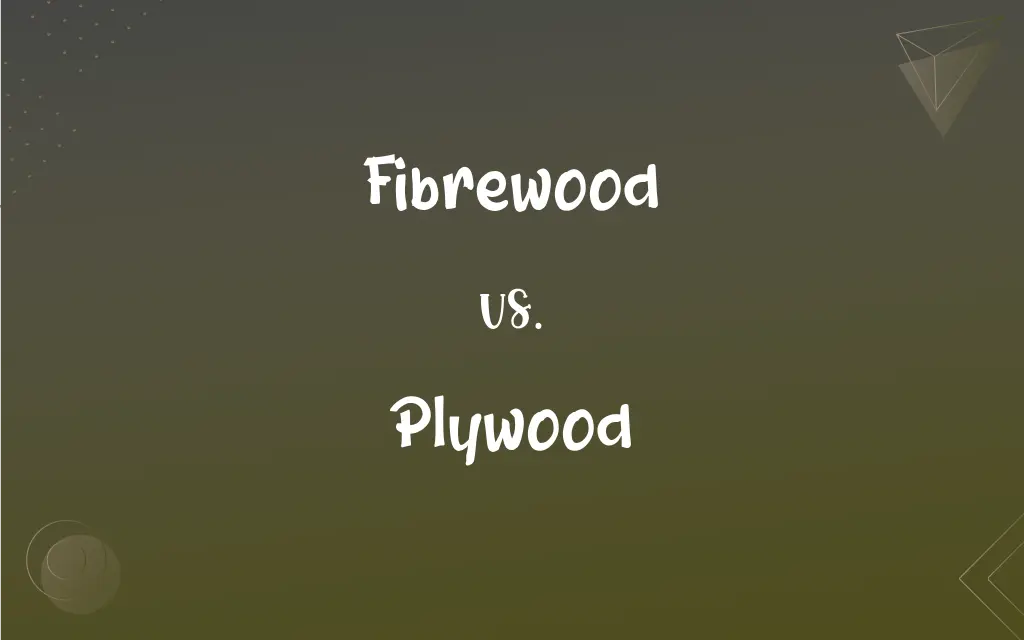Fibrewood vs. Plywood: What's the Difference?
Edited by Aimie Carlson || By Harlon Moss || Updated on November 2, 2023
Fibrewood, or fiberboard, is made by compressing wood fibers with adhesive; plywood consists of layers of wood veneer glued together.

Key Differences
Fibrewood is a type of engineered wood product made from wood fibers bonded together under heat and pressure, whereas plywood is created by gluing multiple layers of wood veneer, with the grain of each layer at a right angle to the adjacent one. This cross-graining in plywood improves strength and prevents warping.
While fibrewood offers a smooth, uniform surface suitable for veneering or painting, plywood provides a stronger structure that can bear heavier loads. Plywood's layered construction makes it less susceptible to expansion and shrinkage compared to fibrewood.
In terms of applications, fibrewood is typically used for furniture, cabinetry, and decorative wall paneling due to its fine texture and consistent density. Plywood, on the other hand, is chosen for its durability and is commonly used in construction for subflooring, external walls, and roofing.
The production process for fibrewood involves breaking down hardwood or softwood residuals into wood fibers, which is different from plywood's requirement of peeling wood veneer from logs. This fundamental difference in manufacturing reflects in their contrasting attributes and cost, with fibrewood generally being less expensive than plywood.
Plywood tends to be preferred for tasks requiring structural strength or exposure to moisture, given its resistance to cracking, splitting, or twisting. Fibrewood, while more cost-effective for interior uses, may not perform as well in conditions where strength and moisture resistance are essential.
ADVERTISEMENT
Comparison Chart
Composition
Wood fibers bonded with resin
Layers of wood veneer glued together
Texture
Smooth and uniform
Grained, may show wood layers
Strength
Lower structural strength
High structural strength
Moisture Resistance
Less resistant to moisture
More resistant to moisture
Cost
Generally less expensive
Generally more expensive
ADVERTISEMENT
Fibrewood and Plywood Definitions
Fibrewood
Provides a smooth surface ideal for veneering.
Fibrewood panels were selected for the interior doors.
Plywood
Wood product of glued layers of veneer.
The contractor used plywood for the subflooring.
Fibrewood
Less suitable for outdoor use than plywood.
They avoided using fibrewood for the exterior due to its lower moisture resistance.
Plywood
Can vary in thickness and number of layers.
The craftsman chose a thick plywood for the shelving.
Fibrewood
Can be eco-friendly when made from recycled materials.
The company prides itself on its sustainable fibrewood products.
Plywood
Suitable for both indoor and outdoor applications.
The outdoor deck was built with treated plywood.
Fibrewood
Engineered wood made from compressed wood fibers.
The designer opted for fibrewood for the sleek finish of the cabinets.
Plywood
Often used in construction for its load-bearing capacity.
The new house features plywood roofing for extra strength.
Fibrewood
Often used in making cost-effective furniture.
The bookshelf was crafted from high-density fibrewood.
Plywood
Offers high strength and resistance to warping.
Plywood is preferred for constructing durable furniture.
Plywood
A structural material made of layers of wood glued together, usually with the grains of adjoining layers at right angles to each other.
FAQs
Where is fibrewood commonly used?
Fibrewood is often used in furniture, cabinetry, and decorative paneling.
What is fibrewood?
Fibrewood is an engineered wood made from compressed wood fibers.
What is plywood?
Plywood is a wood panel made from layers of veneer glued together.
What are the advantages of plywood?
Plywood offers structural strength and resistance to warping.
Is fibrewood environmentally friendly?
Fibrewood can be eco-friendly, especially when made from recycled materials.
What type of wood is more affordable?
Fibrewood is generally more affordable than plywood.
Is plywood waterproof?
Some plywood is treated to be water-resistant, but not all plywood is waterproof.
Does plywood come in different grades?
Yes, plywood is available in various grades for different applications.
Are there different types of fibrewood?
Yes, fibrewood comes in different densities such as medium-density fibreboard (MDF) and high-density fibreboard (HDF).
Can fibrewood be used outdoors?
Fibrewood is generally less resistant to moisture and not recommended for outdoor use.
What should I use for cabinet doors, fibrewood or plywood?
Fibrewood is commonly used for cabinet doors due to its smooth finish.
Is all plywood the same?
No, plywood varies in terms of wood species, thickness, and adhesive used.
How do you cut plywood without splintering?
Use a fine-toothed saw blade and tape the cut line to minimize splintering.
Is plywood good for furniture?
Plywood is strong and durable, making it suitable for furniture-making.
Can plywood be used in high-moisture areas?
Marine-grade plywood is designed to withstand high-moisture environments.
Is fibrewood strong enough for building material?
Fibrewood is not as strong as plywood and is not typically used for structural building materials.
Can plywood be used for flooring?
Yes, plywood is commonly used for subflooring in construction.
Can you paint fibrewood?
Yes, fibrewood's smooth surface makes it ideal for painting.
How is plywood made?
Plywood is made by gluing and pressing layers of wood veneer together.
Can fibrewood be recycled?
Fibrewood can be recycled, depending on the type and condition.
About Author
Written by
Harlon MossHarlon is a seasoned quality moderator and accomplished content writer for Difference Wiki. An alumnus of the prestigious University of California, he earned his degree in Computer Science. Leveraging his academic background, Harlon brings a meticulous and informed perspective to his work, ensuring content accuracy and excellence.
Edited by
Aimie CarlsonAimie Carlson, holding a master's degree in English literature, is a fervent English language enthusiast. She lends her writing talents to Difference Wiki, a prominent website that specializes in comparisons, offering readers insightful analyses that both captivate and inform.































































